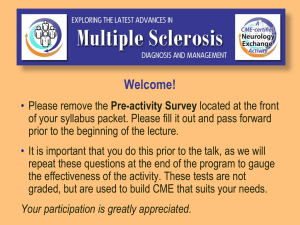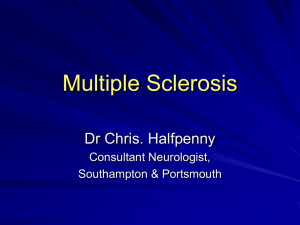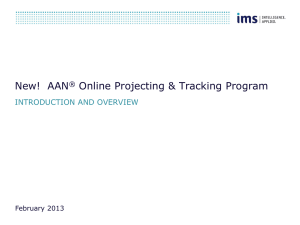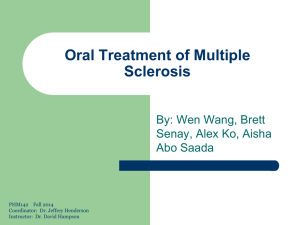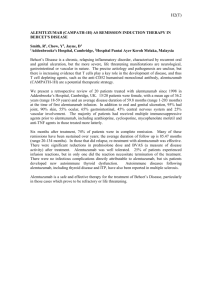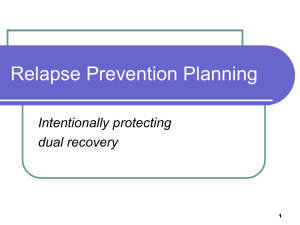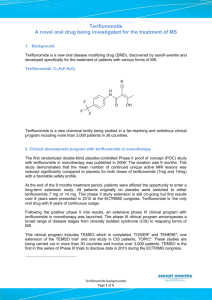Slides - Projects In Knowledge
advertisement
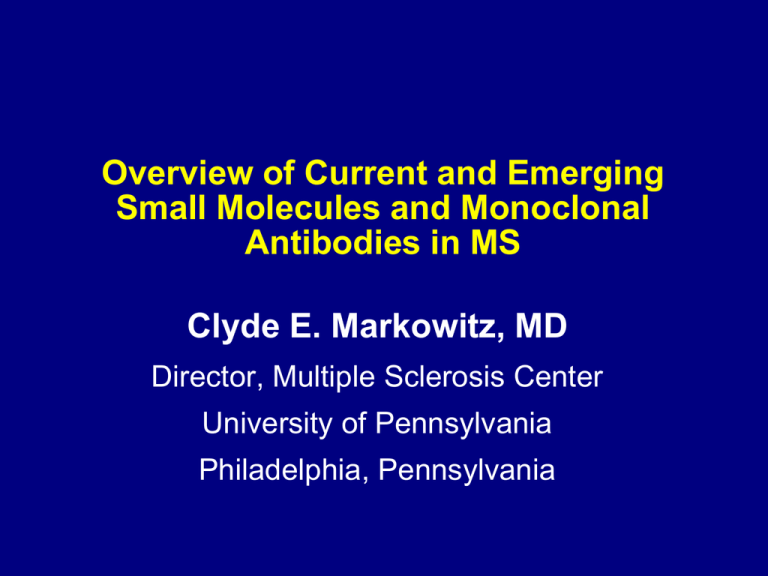
Overview of Current and Emerging Small Molecules and Monoclonal Antibodies in MS Clyde E. Markowitz, MD Director, Multiple Sclerosis Center University of Pennsylvania Philadelphia, Pennsylvania Introduction • Traditional 1st-line MS therapies reduce relapse rates and slow progression – But are only partially effective – Require self-injection – Some have bothersome side effects • The 1st oral small-molecule therapy (fingolimod) and the 1st monoclonal antibody (natalizumab) have now been integrated into MS treatment – Greater potency? More concerning side effects? – Many new small molecules and monoclonal antibodies are in development Case Study • 30-year-old woman has occasional numbness and tingling in left hand for past 6 months. Now presents with optic neuritis • MRI shows multiple T2 hyperintensities in corona radiata and cervical spinal cord • Results of other evaluations consistent with clinically isolated syndrome • After resolution of optic neuritis on corticosteroids, started on glatiramer acetate 20 mg/day • 7 months later, she experiences an episode of imbalance and difficulty walking – Treated with corticosteroids – She has residual symptoms but she is still able to ambulate Case Study • She is switched to IFN β-1b 250 µg SC every other day • 10 months later, she presents with decreased sensation in her right foot, worsening and extending up her leg over the course of 3 days • She complains about injection-site reactions and flu-like symptoms • She is reluctant to continue on injectable medication Case Study MRI She is a possible candidate for small molecule or monoclonal antibody therapy Slide courtesy of Clyde E. Markowitz, MD. Oral Small-Molecule Therapies Oral Agents • Currently approved – Fingolimod • Investigational – Laquinimod – Teriflunomide – Dimethyl fumarate (BG-12) – Cladribine Fingolimod The 1st Oral MS Therapy • Sphingosine-1-phosphate (S1P) receptor modulator1 – Binds to S1P receptors on lymphocytes – Receptors are internalized and degraded – Lymphocytes are sequestered in secondary lymphoid organs Affects naive T-cells, central memory T-cells but not effector T-cells • Possible CNS effect2 – Neurons, astrocytes, oligodendrocytes, and microglia express S1P receptors • Approved dose: 0.5 mg orally once daily3 • Terminal half-life: 6–9 days3 1. Mehling M, et al. Neurology. 2011;76(suppl 3):S20-S27. 2. Osinde M, et al. 22nd ECTRIMS; September 27-30, 2006; Madrid, Spain. Abstract P792. 3. Gilenya [PI]. East Hanover, NJ: Novartis Pharmaceuticals; 2010. Fingolimod Phase III TRANSFORMS Trial N = 1292 RRMS + ≥1 recent relapse 12-month data Fingolimod 0.5 mg/d n = 429 Fingolimod 1.25 mg/d n = 420 IFNβ-1a IM 30 μg QW n = 431 P value Annualized relapse rate 0.16 (-52%) 0.20 (-38%) 0.33 <.001 Relapse-free 83% 80% 69% <.001 Disability progression-free 94% 93% 92% NS % change in brain volume -0.31 -0.30 -0.45 <.001 vs IFN Decreased number of T2 and Gd-enhanced lesions on MRI Cohen JA, et al. N Engl J Med. 2010;362:402-415. Fingolimod Phase III FREEDOMS I Trial N = 1272 RRMS + ≥1 relapse in past year or ≥2 in past 2 years; EDSS ≤5.5 24-month data Fingolimod 0.5 mg/d n = 425 Fingolimod 1.25 mg/d n = 429 Annualized relapse rate 0.18 (-54%) Relapse-free 70% Placebo n = 418 P value vs 0.16 (-60%) 0.40 <.001 75% 46% <.001 Placebo Disability progression-free 82% 83% 76% .03 for 0.5 mg .01 for 1.25 mg % change in brain volume -0.84 -0.89 -1.31 <.001 Decreased number of T2 and Gd-enhanced lesions on MRI Kappos L, et al. N Engl J Med. 2010;362:387-401. Fingolimod Ongoing Trials • FREEDOMS II (phase III)1 – Relapsing-remitting MS – 2 years – Fingolimod 0.5 mg/d vs placebo (1.25 mg/d dropped) • INFORMS (phase III)2 – Primary-progressive MS – ≥3 years – Fingolimod 0.5 or 1.25 mg/d vs placebo • FREEDOMS Extension study3 1. ClinicalTrials.gov. 2011. Accessed July 20, 2011 at: http://www.clinicaltrials.gov/ct2/show/NCT00355134?term=fingolimod+AND+FREEDOMS&rank=2. 2. ClinicalTrials.gov. 2011. Accessed July 20, 2011 at: http://www.clinicaltrials.gov/ct2/show/NCT00731692?term=fingolimod&cond=primaryprogressive+MS&phase=2&rank=1. 3.ClinicalTrials.gov. 2011. Accessed July 20, 2011 at: http://www.clinicaltrials.gov/ct2/show/NCT00662649?term=fingolimod&cond=MS&phase=2&rank=4. Fingolimod Safety Profile • Bradycardia (1–6 hours after 1st dose), atrioventricular block • Blood pressure increases • Infections • Macular edema • Malignancies (mostly skin cancer) • Peripheral-blood lymphocyte count reductions (MOA) • ALT increases (≥3 x ULN in 7%–8.5%) • Mild forced expiratory volume (FEV1) reductions • Drug interactions (ketoconazole, antineoplastic/immunosuppressive drugs, vaccines, drugs affecting heart rate) Kappos L, et al. N Engl J Med. 2010;362:387-401. Cohen JA, et al. N Engl J Med. 2010;362:402415. Gilenya [PI]. East Hanover, NJ: Novartis Pharmaceuticals; 2010. Fingolimod Monitoring • Laboratory – CBC + differential – Liver enzymes/bilirubin (baseline and if symptomatic) – Baseline anti-varicella-zoster virus IgG/IgM (if negative, vaccinate and delay fingolimod 1 month) • Ophthalmologic exam – Baseline and at 3–4 months – Repeat if patient reports visual disturbance • Cardiac – EKG if cardiac risk factors, slow/irregular heartbeat, or taking beta-blockers, calcium channel blockers, or antiarrhythmics – 6-hour observation after 1st dosing – Blood pressure • Spirometry/diffusing capacity of the lung for carbon monoxide – If clinically indicated Gilenya [PI]. East Hanover, NJ: Novartis Pharmaceuticals; 2010. Laquinimod • Novel oral immunomodulatory agent (quinoline-3-carboxamide) • High oral bioavailability1 – 0.6 mg orally once daily2 • Structurally related to roquinimex1 – Unlike roquinimex, does not increase risk of myocardial infarction, serositis • FDA fast-track review status 1. Polman C, et al. Neurology. 2005;64:987-991. 2. Comi G, et al. 63rd AAN; April 9-16, 2011; Honolulu, Hawaii. Laquinimod Mechanism of Action • Induces Th1 to Th2 shift; inhibits proinflammatory cytokine production1,2 • Inhibits leukocyte migration into CNS1 • Deactivates microglia and macrophages3 • Suppresses NFκB pathway in B-cells and NK cells2 • Increases brain-derived neurotrophic factor 11-fold (possible neuroprotection)4 • Not immunosuppressive: cellular/humoral immune responses remain intact1 1. Brück W, et al. J Neurol Sci. 2011;306:173-179. 2. Gurevich M, et al. 62nd AAN; April 1017, 2011; Toronto, Ontario, Canada. Abstract P04.208. 3. Wang J, et al. 62nd AAN; April 1017, 2011; Toronto, Ontario, Canada. Abstract P04.222. 4. Thöne J, et al. 62nd AAN; April 1017, 2010; Toronto, Ontario, Canada. Abstract PD5.004. Laquinimod Phase III ALLEGRO Trial N = 1106 RRMS; 24-month data Laquinimod 0.6 mg/d vs Placebo Annualized relapse rate Disability progression (EDSS) 0.304 vs 0.395—23% reduction RR = 0.770; 95% CI 0.650–0.911; P = .0024 36% reduction HR = 0.641; 95% CI 0.452–0.908; P = .0122) Brain atrophy 33% reduction (P <.0001) Mean cumulative Gd-enhancing lesions 37% reduction (P = .0003) Mean cumulative T2 lesions 30% reduction (P = .0002) Abbreviations: EDSS, Expanded Disability Status Scale; RRMS, relapsing-remitting MS. Comi G, et al. 63rd AAN; April 9-16, 2011; Honolulu, Hawaii. Gever J. MedPage Today. April 14, 2011. Accessed July 21, 2011 at: http://www.medpagetoday.com/MeetingCoverage/AAN/25935?pfc. Laquinimod Ongoing Trials • BRAVO (phase III)1 – Relapsing-remitting MS (N = 1200) – Laquinimod 0.6 mg/day vs oral placebo vs IFNβ-1a 30 µg IM once weekly Double-blind for laquinimod vs placebo; rater-blind for IFN reference arm Primary outcome: relapse rate – Results expected Q3 2011 • 3 open-label extension studies2 1. ClinicalTrials.gov. 2011. Accessed July 20, 2011 at: http://clinicaltrials.gov/ct2/show/NCT00605215?term=BRAVO+Study%3A+Laquinimod+Double+Blind+Place bo+Controlled&rank=1. 2. ClinicalTrials.gov. 2011. Accessed July 21, 2011 at: http://www.clinicaltrials.gov/ct2/show/NCT01047319?term=laquinimod&cond=multiple+sclerosis&rank=1, http://www.clinicaltrials.gov/ct2/show/NCT00745615?term=laquinimod&cond=multiple+sclerosis&rank=5, and http://www.clinicaltrials.gov/ct2/show/NCT00988052?term=laquinimod&cond=multiple+sclerosis&rank=4. Laquinimod Safety Profile Adverse events in phase II and III studies • Transient dose-related ALT increases1,2 • Budd-Chiari syndrome (single case in patient with underlying hypercoagulability)1 • Abdominal/back pain,2 chest pain, arthralgias1 • Herpes infections1 • No cardiac events1,2 1. Comi G, et al. Lancet. 2008;371:2085-2092. 2. Gever J. MedPage Today. April 14, 2011. Accessed July 21, 2011 at: http://www.medpagetoday.com/MeetingCoverage/AAN/25935?pfc. Laquinimod Metabolism/Drug Interactions • Metabolized by CYP3A4 (low affinity) • Strong CYP3A4 inhibitors (eg, ketoconazole) may slow laquinimod metabolism • Unlikely to cause competitive inhibition with other CYP3A4 substrates Preiningerova J. Expert Opin Investig Drugs. 2009;18:985-989. Teriflunomide • Active metabolite of leflunomide (approved for rheumatoid arthritis since 1998) • Noncompetitive reversible inhibition of mitochondrial enzyme dihydro-orotate dehydrogenase (de novo pyrimidine synthesis pathway) • Cytostatic for proliferating T- and B-cells; noncytotoxic • Inhibits protein kinase activity – Decreased T-cell proliferation, activation, cytokine production • Half-life: 2 weeks – Rapid clearance requires cholestyramine Warneke C, et al. Neuropsychiatr Dis Treat. 2009;5:333-340. Teriflunomide Phase III TEMSO Trial N = 1088 relapsing MS (RRMS or SPMS with relapses) 2-year study Placebo Teriflunomide (7 mg/d) Teriflunomide (14 mg/d) Annualized relapse rate 0.539 0.370 31.2% reduction P = .0002 0.369 31.5% reduction P = .0005 12-week sustained disability 27.3% 21.7% 23.7% reduction P = NS 20.2% 29.8% reduction P = .0279 Change in volume of white matter -3.741 -0.635 P = .0609 2.406 P = .0002 39% reduction P = .032 67% reduction P = .0003 Brain MRI total lesion volume Miller A, et al. 63rd AAN; April 9-16, 2011; Honolulu, Hawaii. Abstract S41.002. Wolinsky JS, et al. 63rd AAN; April 9-16, 2011; Honolulu, Hawaii. Abstract S41.003. Gever J. MedPage Today. April 16, 2011. Accessed July 21, 2011 at: http://www.medpagetoday. O'Connor P, et al. 26th ECTRIMS and 15th RIMS; October 13-16, 2010. Goteborg, Sweden. Abstract 79. Teriflunomide Ongoing Trials • TOWER (phase III) – Relapsing MS (N = 1110) – 2 years – Primary outcome: annualized relapse rate – Teriflunomide 7 or 14 mg vs placebo • TENERE (phase III) – Relapsing MS (N = 300) – 48 weeks – Primary outcome: time to treatment failure (relapse or dropout) – Teriflunomide 7 or 14 mg vs IFN β-1a 44 μg SC 3x weekly ClinicalTrials.gov. 2011. Accessed July 20, 2011 at: http://clinicaltrials.gov/ct2/show/NCT00751881?term=tower+%2B+teriflunomide&rank=1 and http://clinicaltrials.gov/ct2/show/NCT00883337?term=tenere++. Teriflunomide Ongoing Trials • TOPIC (phase III) – Clinically isolated syndrome (N = 780) – 2 years – Primary outcome: conversion to clinically definite MS (2nd attack) – Teriflunomide 7 or 14 mg vs placebo • Long-term extensions • Phase II combination therapy trials ongoing ClinicalTrials.gov. 2011. Accessed July 20, 2011 at: http://clinicaltrials.gov/ct2/show/NCT00622700?term=topic+%2B+teriflunomide&rank=1, http://clinicaltrials.gov/ct2/show/NCT00228163?term=extension+%2B+teriflunomide&rank=2 and http://clinicaltrials.gov/ct2/show/NCT00803049?term=teriflunomide&rank=9. Teriflunomide Safety Profile • Adverse effects in phase II study1 – ALT elevations – Nasopharyngitis – Alopecia – Nausea, diarrhea – Paresthesias – Back pain, limb pain, arthralgias • Hepatic metabolism2 • Inhibits CYP2C9, enhancing warfarin’s anticoagulative effects2 • Teratogenic in animal studies, so washout with cholestyramine/activated charcoal and confirmation of plasma level <0.02 mg/L recommended before conception1 1. O’Connor PW, et al. Neurology. 2006;66:894-900. 2. Warneke C, et al. Neuropsychiatr Dis Treat. 2009;5:333-340. Dimethyl Fumarate (BG-12) • Exact mechanism of action is unclear – Inhibits expression of proinflammatory adhesion molecules and chemokines1 – Suppresses macrophage function2 – Increases Nrf2 DNA binding (possible neuroprotection)3 – Suppresses inflammatory activation of astrocytes and C6 glioma cells3 • FDA fast-track review status 1. Moharregh-Khiabani D, et al. Curr Neuropharmacol. 2009;7:60-64. 2. Bista P, et al. 61st AAN; April 25May 2, 2009; Seattle, Wash. Abstract P09.114. 3. Lin SX, et al. ASN Neuro. 2011; Epub ahead of print. Dimethyl Fumarate Phase III DEFINE Trial • Relapsing-remitting MS (N >1200) • Dimethyl fumarate 240 mg 2 or 3 times daily vs placebo for 2 years • Preliminary data reported only via press release to date – Significant reduction in proportion relapsing at 2 years for both treatment arms – Both treatment arms showed positive results on all secondary outcomes Relapse rate MRI outcomes Expanded Disability Status Scale progression ClinicalTrials.gov. 2011. Accessed July 20, 2011 at: http://clinicaltrials.gov/ct2/show/NCT00420212?term=multiple+sclerosis+%2B+define&rank=1. NMSS. April 14, 2011. Accessed July 21, 2011 at: http://www.nationalmssociety.org/news/newsdetail/index.aspx?nid=4903. Dimethyl Fumarate Ongoing Trials • CONFIRM (phase III)1 – Relapsing-remitting (N = 1232) – Dimethyl fumarate 240 mg 2 or 3 times per day vs placebo vs glatiramer acetate for 2 years – Primary outcome: relapse rate – Results in 2nd half of 2011 • 2-year extension study2 1. ClinicalTrials.gov. 2011. Accessed July 20, 2011 at: http://clinicaltrials.gov/ct2/show/NCT00451451?term=fumarate+%2B+confirm&rank=1. 2. ClinicalTrials.gov. 2011. Accessed July 20, 2011 at: http://clinicaltrials.gov/ct2/show/NCT00835770?term=fumarate+%2B+extension+study+%2B+multiple+scl erosis&rank=1. Dimethyl Fumarate Safety Profile • Nausea, diarrhea, abdominal pain • Flushing • Headache • Fatigue • Adverse events are dose-related Kappos L, et al. Lancet. 2008;372:1463-1472. Cladribine Approval Status • Approved in Australia and Russia; rejected in EU • FDA rejected approval – Single phase III CLARITY trial1 Significant reductions in relapse rate, brain lesion counts, and 3-month sustained disability Lymphocytopenia, infections/infestations (especially herpes zoster) – FDA requested additional data to clarify safety and risk-benefit profile – Manufacturer has chosen to no longer pursue development of oral cladribine for MS 1. Giovannoni G, et al. N Engl J Med. 2010;362:416-426. Monoclonal Antibodies Monoclonal Antibodies • Currently approved – Natalizumab • Investigational – Alemtuzumab – Rituximab and ocrelizumab – Daclizumab Natalizumab • Humanized monoclonal antibody targeting α4 subunit of α4β1 and α4β7 integrins on leukocytes, preventing them from binding their receptors on vascular endothelial cells1 – May prevent migration of leukocytes across endothelial cells of blood-brain barrier1 • Phase III trial (AFFIRM)2 – 68% reduction in relapse rate – 83% reduction in new/enlarging hyperintense T2 lesions – 92% reduction in Gd-enhancing lesions – 42% reduction in risk of sustained progression of disability • 300 mg IV infusion given over 1 hour every 4 weeks1 1. Tysabri [PI]. Cambridge, Mass: Biogen Idec; 2011. 2. Polman CH, et al. N Engl J Med. 2006;354:899-910. Natalizumab Progressive Multifocal Leukoencephalopathy • Viral brain infection (JC virus)1 • Overall incidence is 1.23 cases per 1000 patients treated2 – Incidence varies with presence of risk factors • Progresses to severe disability or death1 • Plasma exchange helps clear natalizumab1 - Is followed by immune reconstitution inflammatory syndrome in almost all cases1 • TOUCH prescribing program1 • Natalizumab used only after failure of other options1 1. Tysabri [PI]. Cambridge, Mass: Biogen Idec; 2011. 2. Sandrock A, et al. 63rd AAN; April 9-16, 2011; Honolulu, Hawaii. Poster P03.248. Natalizumab PML Risk Factors • Duration of use/number of infusions – 1.53 cases per 1000 patients treated with ≥12 infusions – 2.41 cases per 1000 patients treated with ≥24 infusions • JC virus antibodies – About 55% of MS patients are Ab positive – 2.24 cases per 1000 patients if Ab positive – ≤0.11 cases per 1000 patients if Ab negative (theoretic; all cases Ab+) • Prior immunosuppressive (IS) therapy – Increases risk 4-fold • Risk is further increased if ≥1 risk factors – 4.5 cases per 1000 patients if history of IS therapy + natalizumab use ≥2 years – 8.1 cases per 1000 patients if history of IS therapy + Ab positive + natalizumab use ≥2 years Abbreviation: PML, progressive multifocal leukoencephalopathy. Sandrock A, et al. 63rd AAN; April 9-16, 2011; Honolulu, Hawaii. Poster P03.248. Alemtuzumab • Humanized monoclonal antibody directed against CD52 antigen – CD52 is a cell-surface glycoprotein of unknown function, present on most T-cells, B-cells, NK cells, dendritic cells, eosinophils, monocytes, macrophages • Depletes CD52-expressing cells • Stabilizes blood-brain barrier • Annual infusion (3 or 5 days) given with corticosteroids • Fast-track FDA status Bielekova B, et al. Neurology. 2010;74:S31-S40. Alemtuzumab’s Effects on the Immune System • Within 1 hour after single 5- to 10-mg dose, lymphocytes and monocytes are no longer detectable in circulation1 Median Time to Recovery After Discontinuation of Alemtuzumab CD4+ T-cells1 61 months CD8+ T-cells1 30 months Monocytes1 3 months B-cells1,2 3 months • B-cells rise to 165% of pretreatment levels after 12 months posttreatment2 1. Coles A, et al. J Neurol. 2006;253:98-108. 2. Thompson SA, et al. J Clin Immunol. 2010;30:99105. Alemtuzumab 5-Year Follow-Up of Phase II CAMMS223 Untreated RRMS (N = 334) Alemtuzumab (Combined Data*) IFN β-1a 44 µg SC TIW Annualized relapse rate Years 0–5 Years 3–5 0.11 0.14 0.35 0.28 Relapse-free 72% 41% Change from baseline in EDSS -0.30 +0.46 Patients free of sustained accumulation of disability 87%† 62%† Free of clinical disease activity 65% 27% *Alemtuzumab 12 or 24 mg/day for 5 days in month 1 and 3 days in month 12; 3 additional days in month 24 at physician’s discretion. †P <.0001; P values were not reported for the other comparisons. Coles A, et al. 26th ECTRIMS and 15th RIMS; October 13-16, 2010. Goteborg, Sweden. Poster 410. Twyman C, et al. 63rd AAN; April 9-16, 2011; Honolulu, Hawaii. Abstract PD6.003. Alemtuzumab Phase III CARE-MS I Trial Recently completed but reported only in press release form1,2 • Treatment-naive relapsing-remitting MS (N = 581) • Alemtuzumab 12 mg/day x 5 days + 3 days at month 12 vs IFN β-1a SC 44 μg for 2 years (rater blinded) • 55% reduction in relapse rate (P <.0001) • Time to 6-month sustained accumulation of disability not significantly different • Proportion of patients with sustained increase in disability not significantly different (8% vs 11%; HR = 0.70; P = .22) – Few patients accumulated disability at the rate expected based on earlier trials, which may have reduced ability to detect significant treatment effect on this endpoint 1. Gandey A. Medscape Today July 12, 2011. Accessed July 22, 2011 at: http://www.medscape.com/viewarticle/746184. 2. ClinicalTrials.gov. 2011. Accessed July 20, 2011 at: http://www.clinicaltrials.gov/ct2/show/NCT00530348?term=alemtuzumab+AND+multiple+sclerosis&ran k=4. Alemtuzumab Ongoing Phase III Trials • CARE-MS II – MS with relapse during IFN or glatiramer acetate and ≥2 attacks in past 24 months or ≥1 attack in past 12 months (N 840) – Alemtuzumab 12-mg dose (24-mg dose dropped) vs IFN β-1a SC 44 μg for 2 years (rater-blinded) • CARE-MS extension – N 1500 – 5 years – Can receive additional cycles if resumed disease activity ClinicalTrials.gov. 2011. Accessed July 20, 2011 at: http://clinicaltrials.gov/ct2/show/NCT00548405?term=alemtuzumab+%2B+multiple+sclerosis+%2B+car e&rank=1 and http://clinicaltrials.gov/ct2/show/NCT00930553?term=alemtuzumab+%2B+multiple+sclerosis+%2B+car e&rank=4. Alemtuzumab Safety Profile • Cytokine release syndrome: fever, rash, headache, nausea/vomiting, rigor1,2 • Autoimmune disease (primarily thyroid dysfunction): 30%1,2 • Immune thrombocytopenic purpura: ~3%1,2 • Goodpasture’s syndrome: at least 2 cases3 • Infections (~66%): upper and lower respiratory tract, urinary tract, herpes, influenza2 • Cancers: Burkitt’s lymphoma, breast cancer, cervical cancer2 • Serious infusion reactions: 1.4%2 1. Minager A, et al. Expert Opin Biol Ther. 2010;10:421-429. 2. CAMMS223 Investigators. N Engl J Med. 2008;359:1786-1801. 3. Buttmann M. Expert Rev Neurother. 2010;10:791-809. Alemtuzumab Monitoring • Complete blood count monthly1 • Thyroid-stimulating hormone every 3−4 months1 • Pretreatment: hydroxyzine or diphenhydramine, meperidine, acetaminophen1 • Posttreatment: prophylactic acyclovir, trimethoprim/sulfamethoxazole x 6 months1 • Creatinine and urinalysis screening2 • Autoimmunity screen? – Increased IL-21, autoantibodies, genetic2 1. Hunter SF, et al. 61st AAN; April 25-May 2, 2009; Seattle, Washington. Poster P07.147. 2. Clyde Markowitz, MD, personal communication, July 2011. B-Cells and CD20 in MS • B-cell role: antigen presentation, cytokine production, antibody secretion (plasma cells)1,2 • CD20: transmembrane protein – Functions as Ca+2-permeable cation channel and has role in B-cell proliferation3 – Present on premature, immature, mature, activated, and memory B-cells and small subset of normal/neoplastic T-cells (low density)2 Not on plasma cells2 – Not shed after antibody binding2 • CD19 also present on pre−B-cells2 1. McFarland HF. N Engl J Med. 2008;358:664-665. 2. Dalakas MC. Neurology. 2008;70: 22522260. 3. Uchida J, et al. Int Immunol. 2004;16:119-129. Rituximab • IgG1 chimeric anti-CD20 monoclonal antibody1 • Approved for non-Hodgkin’s lymphoma, chronic lymphocytic leukemia, refractory rheumatoid arthritis (with methotrexate)1 – Indication for MS not being pursued • Rapid depletion of B-cells2 – B-cells remain depleted for about 6 months2 – Naive B-cells return more quickly than memory B-cells3 1. Rituxan [PI]. South San Francisco, Calif: Genentech; 2011. 2. Hauser SL, et al. N Engl J Med. 2008;358:676. 3. Roll P, et al. Arthritis Rheum. 2006;54:2377-2386. Rituximab in RRMS 48-Week Phase II Study N = 104 Rituximab dose: 1000 mg IV days 1 and 15 Placebo (n = 35) Rituximab (n = 69) P value Mean number of Gd-enhancing lesions 5.5 0.5 <.001 Mean Δ in volume of T2 lesions from baseline to week 36 (mm3) 417.8 -175.4 .004 Patients with relapses 40% 20.3% .04 Adjusted annualized relapse rate 0.7 0.4 .08 • 95% reduction from baseline in CD19+ B-cells at weeks 2–24; 30.7% of baseline at 48 weeks • 24.1% had human antichimeric antibodies at week 48 Hauser SL, et al. N Engl J Med. 2008;358:676-688. Rituximab in PPMS 96-Week Phase II/III Study N = 439 PPMS with abnormal cerebrospinal fluid, EDSS 2.0–6.5 Rituximab 1000 mg IV days 1 and 15 every 24 weeks (n = 292) vs placebo (n = 147) Disease progression at 96 weeks Placebo Rituximab P Value 38.5% 30.2% NS In age <51 years HR = 0.52 .010 In patients with Gd+ lesions HR = 0.41 .007 In age <51 + Gd+ lesions HR = 0.33 .009 Median Δ T2 lesion volume (mm3) 809.5 302.0 .001 Median Δ brain volume -14.0 -13.1 NS Longer time to progression if shorter (≤3 years) disease duration; no gender effect Hawker K, et al. Ann Neurol. 2009;66:460-471. Rituximab Safety Profile • Infusion reactions: fever, chills, rigors, flu-like symptoms, hypotension, nausea, pruritus, asthenia1 • Infections (respiratory tract, urinary tract)1 • Progressive multifocal leukoencephalopathy – Majority in patients using rituximab in combination with chemotherapy for hematologic malignancies or in patients with prior or concurrent immunosuppressive therapy 1. Hauser SL, et al. N Engl J Med. 2008;358:676-688. Humanized Anti-CD20 Monoclonal Antibodies • Ocrelizumab – Enhanced antibody-dependent cell-mediated cytotoxicity; reduced complement-dependent cytotoxicity – Binds to different overlapping epitope • Ofatumumab – Binds to more proximal CD20 portions – Increased complement-dependent cytotoxicity Buttmann M. Expert Rev Neurother. 2010;10:791-809. Ocrelizumab 48-Week Phase II Trial Relapsing-Remitting MS (N = 220) Study Protocol Cycle 1 (Weeks 0–24) Cycle 2 (Weeks 25–48) Group A Double-blind Placebo on days 1 and 15 Ocrelizumab 300 mg IV on days 1 and 15 (600 mg total) Group B Double-blind Ocrelizumab 300 mg IV on days 1 and 15 (600 mg total) Ocrelizumab 300 mg IV on days 1 and 15 (600 mg total) Group C Double-blind Ocrelizumab 1000 mg IV on days 1 and 15 (2000 mg total) Ocrelizumab 500 mg IV on days 1 and 15 (1000 mg total) Group D Open-label IFN β-1a 30 µg IM once weekly Ocrelizumab 300 mg IV on days 1 and 15 (600 mg total) Kappos L, et al. 63rd AAN; April 9-16, 2011; Honolulu, Hawaii. Abstract S41.001. Ocrelizumab Phase II Trial Cycle 1 (Weeks 0–24)1 Group A Placebo Relative reduction in Gd+ lesions vs placebo* Annualized relapse rate (ARR) Δ T2 lesion volume 0.637 Group B OCR 600 mg Group C OCR 2000 mg 89% P <.0001 96% P <.0001 0.125 80% reduction P = .0005 0.169 73% reduction P = .0014 NS NS *Both ocrelizumab arms were also significantly superior to IFN. Cycle 2 (Weeks 0–24)—all groups taking ocrelizumab2 • ARR = 0.112 in Group B, 0.256 in Group C • 80% and 73% relapse-free, respectively 1. Kappos L, et al. 26th ECTRIMS and 15th RIMS; October 13-16, 2010. Goteborg, Sweden. Poster P114. 2. Kappos L, et al. 63rd AAN; April 9-16, 2011; Honolulu, Hawaii. Abstract S41.001. Ocrelizumab Ongoing Phase III Trials • OPERA I and II1 – Relapsing-remitting MS (N = 800 each) – Ocrelizumab 2 x 300 mg IV followed by 600 mg IV every 24 weeks vs IFNβ-1a 44 μg SC 3 times weekly – Primary outcome: annualized relapse rate at 96 weeks; time to sustained disability progression • ORATORIO2 – Primary-progressive MS (N = 630) – Ocrelizumab 600 mg IV every 24 weeks vs placebo – Age 18–50 years, EDSS 3.0–6.5, abnormal CSF If EDSS ≤5, disease duration <10 years If EDSS >5, disease duration <15 years – Primary outcome: time to sustained progression 1. Clyde Markowitz, MD, personal communication, July 2011. 2. Montalban X, et al. 63rd AAN; April 9-16, 2011; Honolulu, Hawaii. Abstract P04.186. Ocrelizumab Safety Profile • Infusion reactions occurred in 34% and 46% of the 2 ocrelizumab arms in the phase II trial vs 9.3% of placebo arm at 1st infusion – Rates comparable to placebo at 2nd infusion • 1 death from brain edema after systemic inflammatory response syndrome with multiorgan failure 12 weeks after starting ocrelizumab • Rates of infection similar to placebo Kappos L, et al. 26th ECTRIMS and 15th RIMS; October 13-16, 2010. Goteborg, Sweden. Poster P114. 2. Kappos L, et al. 63rd AAN; April 9-16, 2011; Honolulu, Hawaii. Abstract S41.001. Ofatumumab Phase I/II Dose-Finding Study • Relapsing-remitting MS and 1 of the following (N = 38) – ≥2 relapses in past 2 years – ≥1 relapse in past 1 year – 1 relapse in year 2 plus 1 Gd+ brain lesion in past year • Ofatumumab 100, 300, or 700 mg IV at weeks 0 and 2 vs placebo • New Gd+ lesions from weeks 8–24: 0.04 for ofatumumab (combined) vs 9.69 for placebo – Relative risk reduction 99.8% (95% CI 94.7%–100%; P <.001) • No safety signals Sorensen P, et al. 63rd AAN; April 9-16, 2011; Honolulu, Hawaii. Abstract P01.265. Daclizumab • Humanized IgG1 monoclonal antibody against IL2R chain (CD25)1,2 – CD25 is expressed on activated T-cells and B-cells, but these cell counts only modestly affected1,2 – Increases CD56bright NK cell function and number1,2 • Approved for renal transplant rejection but marketing discontinued 1. Schippling S, et al. Intl MS J. 2008;15:94-98. 2. Stüve O, et al. Lancet Neurol. 2010;9:337-338. Daclizumab 24-Week Phase II CHOICE Trial Relapsing-remitting MS with ≥1 relapse or Gd+ lesions on IFN (N = 230)1 IFN + Placebo (n = 77) IFN + Daclizumab 1 mg/kg SC q4wk (n = 78) IFN + Daclizumab 2 mg/kg SC q2wk (n = 75) Mean number new/enlarged Gd+ lesions 4.75 3.58 25% reduction P = NS 1.32 72% reduction P = .004 Mean number new/enlarged T2 lesions 3.4 2.2 P = NS 1.1 P = .007 Unadjusted annualized relapse rate 0.86 0.58 32% reduction P = NS 0.49 43% reduction P = NS • Other small phase II trials document clinical and MRI benefits2,3 – 1–2 mg/kg every 2–4 weeks (IV or SC) 1. Wynn D, et al. Lancet Neurol. 2010;9:381-390. 2. Bielekova B, et al. Arch Neurol. 2009;66:483-489. 3. Rose JW, et al. Neurology. 2007;69:785-789. Daclizumab Safety Profile • • • • • • • Rash Lymphadenopathy Infections Fever Headache Mouth ulcers Elevations of bilirubin, hepatic enzymes, autoantibodies – Monitoring: routine blood tests Wynn D, et al. Lancet Neurol. 2010;9:381-390. Bielekova B, et al. Arch Neurol. 2009;66:483-489. Rose JW, et al. Neurology. 2007;69:785-789. Schippling S, et al. Intl MS J. 2008;15:94-98. Conclusions Conclusions • New MS therapies are on the horizon – Will expand choices for treatment, and options for routes of administration and dosing schedules – Will add to treatment complexity – Personalized medicine • Novel mechanisms of action will raise concern about unknown, rare, or long-term safety issues – Risk:benefit ratio analysis • Future focus – Optimal drug selection, induction/combination strategies, when/how to switch, CNS repair strategies To be discussed in the next webcast in this series Thank you for your participation. To earn CME/CE credit, please complete the posttest and evaluation. (Click link in the navigation bar above or to the left of the slide presentation.) Your feedback is appreciated and will help us continue to provide you with clinically relevant educational activities that meet your specific needs.
